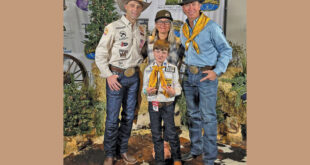Part three: Navigating the local nonprofIt landscape
by Richard Kadzis
Expanding an organization’s budget, whether it’s for- or not-for-profit, is no small task and that applies to KBUT.
With rural community radio stations like KBUT, the challenge is made more pronounced by the competition, often indirect, for philanthropic and charitable contributions in rural marketplaces like Crested Butte. The inevitable supply versus demand question arises; there simply aren’t as many donors at the local level of more remote communities, and not nearly as much financial critical mass found in major markets.
For KBUT to realize a 30 percent growth in budget and for it to attain the half-million dollar threshold, the station must navigate upstream. While the Biery-Witt Arts Center, The Crested Butte Land Trust, the Adaptive Sports Center, and other established charitable causes are raising significant funding, KBUT must seek a balanced approach to sustain itself, too.
But against this Darwinian backdrop of adapt or perish, KBUT represents symbiosis, or productive coexistence of otherwise potential conflicting interests. For one thing, the station helps many other nonprofits in the Gunnison Valley through regular on-air public service announcements and in-depth interviews on shows such as “The West Elk Word.”
The local arts benefit, for sure. The recent addition of remote broadcasting equipment is bringing live programming from the Center for the Arts to listeners everywhere. KBUT recently broadcasted live concert performances by the Chris Robinson Brotherhood and Leftover Salmon.
It’s an upgrade resulting from the expanded local support needed to keep pace with the CPB funding mandate.
Without a doubt, KBUT serves as the key channel for the creative, arts and lifestyle groups that also define the Gunnison Valley counter-culture.
Arts Advisor Magazine did a cover story earlier this year on “The Making of an Arts Community—How Creatives Evolutionized Crested Butte,” reporting that “KBUT has become a nucleus within the extensively diverse visual, performing and literary arts of the Gunnison Valley… a vital channel for the arts community to promote their rich offerings to the wider community.”
“So many folks appreciate KBUT’s programming and what we do,” former general manager Eileen Hughes told the Crested Butte News in a recent interview. “We are considered an essential service in the community.”
KBUT operations and program director Jackson Petito views the station as a major nonprofit multiplier. “When people ask us about which local nonprofits to support, I say, ‘Why don’t you support the one nonprofit that supports every other nonprofit?’”
The Gunnison Valley is full of amazing, giving people, Petito points out. “As a result, we’re surrounded by many, many fantastic nonprofits. How do you decide which one to support? While you’re thinking about that, think about this: KBUT offers airtime for every nonprofit in the valley to further their missions and inform about their fundraisers. So when you support KBUT, you support the entire nonprofit community in the Gunnison Valley.”
According to Mike Henry of Paragon Media Strategies, “Community radio stations often work in difficult funding environments and in rural and non-affluent areas. Community media is often the only locally based, locally focused media in communities of color and rural areas, giving it the opportunity to empower audiences and build community.”
Henry, a public and community radio consultant, also points out, “Like commercial radio and the bigger non-commercial stations, community radio audiences have continuous access to digital media on a multitude of devices. These stations are competing with quality, engaging programming on-air and through other channels—such as through digital media and live events.”
Because the staffs and volunteers from these stations are dedicating their lives to helping improve their communities, “The people who run them are the Peace Corps of radio, and we should all be thankful for their existence,” Henry believes.
KBUT’s general manager Julia Brazell echoes Henry’s point of view, cautioning, “Access to the free airwaves is also a big issue, like our funding challenges. It’s another form of disruptive change as KBUT enters its fourth decade of operation. It’s important to sustain KBUT for this reason, too, because it represents our freedoms and our liberties for access to the publicly owned airwaves versus commercial interests.”
With the proliferation of commercial broadcast media conglomerates, the original intent of broadcasting as a local medium is being diluted, and community radio stations have become a special breed among radio stations today, especially as the media conglomerates continue buying out large chunks of the commercial broadcast spectrum.
“We remain locally accessible and locally responsive,” Brazell stresses. “We see the station as a public resource with a shared ownership of the airwaves across the whole community.”
The Communications Act of 1988 and the resulting federal deregulation of commercial broadcasting has given corporate interests a carte-blanche for consolidation and monopolization, while ironically the community radio sector faces tougher standards for matching federal funds, which could be viewed as a form of higher regulation in itself.
While the basic structure of local commercial broadcasting has become less local and more centralized, technology’s relentless advance has also become a factor adding to disruptive change.
Digital media have become a two-edge sword for KBUT and other community radio stations. The threat comes from on-demand media like Pandora and Spotify, as well as Sirius XM and other satellite radio networks. “But these are subscription services,” Brazell offers. “And we maintain the advantage of unpaid programming and free access to the airwaves, while at the same time offering an open digital archive that keeps getting deeper and deeper.”
Bud Bush, KBUT board member and volunteer DJ of the “Transistor Radio” program says keeping in touch with listeners is key. “We will thrive, but we need to continually survey our listeners and our community to find out what is important to them – news (local/ national), community info, events, pets, music formats, national syndication, and maybe more. If we provide what is important and desirable to them, we will continue to be relevant and successful in the valley,“ he says. “I also like the expansion of our news service – since our town only has a local newspaper once per week, we can provide daily updates on current events that are very relevant and important.”
Just as KBUT is reinvesting its expanded local funding in remote broadcast technology, the station is also increasing its local and state news coverage. Former program director Chad Reich is now serving as KBUT news director. He produces, airs and posts multiple daily newscasts covering any number of key issues like the Gunnison Valley affordable housing shortage, the resolution of the Red Lady Mine’s future use and redevelopment, or the possibility of oil drilling in the local area.
KBUT is a vital information source not just for long-running local issues but for emergencies and crises, storms, power outages, road damage or repairs, threats like wild fires, flooding or other disruptions.
A big part of KBUT’s programming and content enhancements are within news and public affairs.
According to Reich,
“KBUT has really upped our level of commitment to the community by adding a full-time position to monitor local news events in the Gunnison Valley. We’re able to commit resources to informing the public of what’s happening with internet and cellular outages, natural disasters such as the Walrod and Rosebud fires, and road closures caused by accidents and construction. We quickly take to the airwaves and on social media with news updates. We cover deeply important community issues such as housing, development, local politics, tourism, recreation, and everything else that finds itself in the community’s spotlight. Our mission is to ‘…enrich and unify the Gunnison Valley through information, entertainment, and community affairs.’ With the creation of an internal local news department, we’ve put the finishing touches on that long-running mission, and we couldn’t be more pleased to add it.”
Will we ever face a world without KBUT in it? After all, some stations have lost their CPB matching funds, such as KZMU in Moab, Utah, and are scrambling to reposition.
“That’s not likely going to happen,” assures Bob Brazell. “We’re part of the fabric of the Crested Butte experience, and our roots run deeper than a lot of other community stations.”
“Is KBUT a fragile entity?” asks Lynda Jackson. “No. KBUT will always find a way to stay on the air. Changes will come, yes, but we will be there in the future state. I saw how we went from getting $2,000 in yearly pledges to surpass the $40,000 level, per both of our annual capital campaigns.”
So as this Shangri-La of a Colorado Alpine town embraces a lifestyle far removed from the daily routines of most other places, its people understand that realizing the dream every day means hard work and a commitment to the assets and resources, like KBUT, that make it a place worth staying.
“KBUT will definitely be here tomorrow,” predicts Tyler Lucas, “because of the support of the local community, businesses and other organizations. It’s also because of the foresight of the board, staff and volunteers who are helping us become much more self-sufficient.” That includes realizing the goal of one day not having to rely on federal matching grants.
“Have a great weekend,” Lonesome Bob intones as he closes his Friday afternoon show. “And remember, let the KBUT airwaves help you make the most of life at the top of the world!”
About the Author: Story author Richard Kadzis is a former New England correspondent for NPR’s All Things Considered based at WBUR-FM in Boston and a cofounder of WCNI-FM, a community radio station on the campus of Connecticut College. He is also a commentator for NPR member station KRWG-FM at New Mexico State University. Kadzis is also a regular DJ at KBUT-FM, where he is known as the Buzzman.
 The Crested Butte News Serving the Gunnison Valley since 1999
The Crested Butte News Serving the Gunnison Valley since 1999


